

A: Innenstadt, Köln, Nordrhein-Westfalen, Germany
In 1474 printer Arnold Ther Hoernen of Cologne, Germany issued the first dated printed edition of the Fasciculus temporum by Werner Rolevinck, a monk in the Carthusian Monastery of Santa Barbara in Cologne. A world chronicle from the creation to Pope Sixtus IV, the title of Rolevinck's book may be translated as Bundle of Dates. When his book was first printed Rolevinck was 49 years old; he lived until 1502. During the 15th century there were 33 different printed editions and translations of Fasciculus temporum, making it one of the greatest best-sellers in print of the 15th century, and most probably the best-selling printed book of the 15th century by a living author.
Another undated edition of Rolewinck's book was published by Nicholaus Götz, probably in Cologne and not before 1474. Götz's edition was the first fifteenth century printed book issued with pagination rather than foliation:
"Pagination began in England in the XIIIth century, making its way slowly from there to the continent where it was used, with very few exceptions, only in the northern parts of Europe and as far south as the middle and upper Rhine valley. Its first appearance in a printed book (Rolewinck's Fasciculus temporum , ca. 1473-4; H. 6917) was in Cologne, one of many examples of the influence of regional characteristics of manuscripts on printed books. In retrospect it seems surprising that the advantages of foliation, pagination and alphabetical indexing were realized so late, but the reasons are quite clear. A manuscript, being unique, served one or few readers, the printed book many. When texts were produced by printing, all copies were identical and care was taken regularly to number folios or pages and to prepare careful tables of contents and indexes. During the manuscript period citations were cumbersome, since they had to refer to chapters or other clearly defined parts of texts. Accurate citations developed as the direct result of printing, when it became clear that references by edition and folio (or page) were the simplest and most accurate form. This occurred first in the text, then in marginal notations and ultimately in footnotes" (Hirsch, Printing, Selling and Reading 1450-1550 [1967] 6).
Rolevinck's work also contains some of the earliest evidence of collaboration between an author and his printer in the design of printed books. A few contemporary manuscripts that have survived, such as those for the Nuremberg Chronicle, are similar to the complex typography and woodcuts of the printed edition, but none have been demonstrated to be the author's exemplar for the printer. (Wilson, The Making of the Nuremberg Chronicle [1976] 38-41).
In the colophon of the 1474 dated first edition of Rolevinck's book printer Arnold Ther Hoernen stated that he was printing from a manuscript provided by the author. A translation of that reads: "following the first exemplar which this venerable author himself wrote by hand completely." Perhaps this manuscript also provided a model layout for Ther Hoernen to follow. If so, he seems to have had great difficulty with the complicated page designs:
"The Fasciculus temporum, a fifty-age linear chart that moved from the Creation to the present, set out to give readers an overview of world history: a readable visual presentation that they could treat as both a memory system and as the spark for religious meditation. Rolevinck used a system of coordinated circles to locate biblical, classical and modern rulers and writers in the flow of historical time—a system so complicated that the first printer who grappled with it botched the job, producing an unintelligible text; later printers reasurred readers that they had followed the author's manuscript. And the results were most impressive: a neatly designed, powerfully horizontal line of time plunging forward from the Creation to the present. Around it nearly arranged and coordinated name bubbles and extracts from historical texts put meat on the book's numerical bones" (Rosenberg & Grafton, Cartographies of Time [2010] 28-30, with illustrations).
Regarding the art of printing Rolevinck wrote:
"This is the art of arts, the science of sciences, through the swift practice of which the valuable treasures of wisdom and of knowledge, instinctively desired by all men, leap as it were from the deep shadows of their hiding places, and enrich and illuminate this world in its evil state. The unlimited virtue of books which formerly in Athens or Paris and the other schools or sacred libraries was made known to a very few students is now spread by this discovery to every tribe, people, nation, and language everywhere, a true fulfillment of Proverbs, ch. 1" (http://www.lib.rochester.edu/index.cfm?PAGE=3422, accessed 06-15-2012).
For the 1474 Cologne printing see ISTC No. ir00254000. In December 2012 a digital facsimile of the first edition was available from the Universität zu Köln at this link.
For the undated Götz printing see ISTC no. ir00253000. In November 2013 a digital facsimile of this edition was available from Heinrich Heine Universitäts-und Landesbibliothek in Düsseldorf at this link
According to the catalogue description of a fifteenth century manuscript of Fasiculus temporum sold at auction by PBA Galleries for $102,000 on June 21, 2012, thirteen manuscript copies of the work survived.